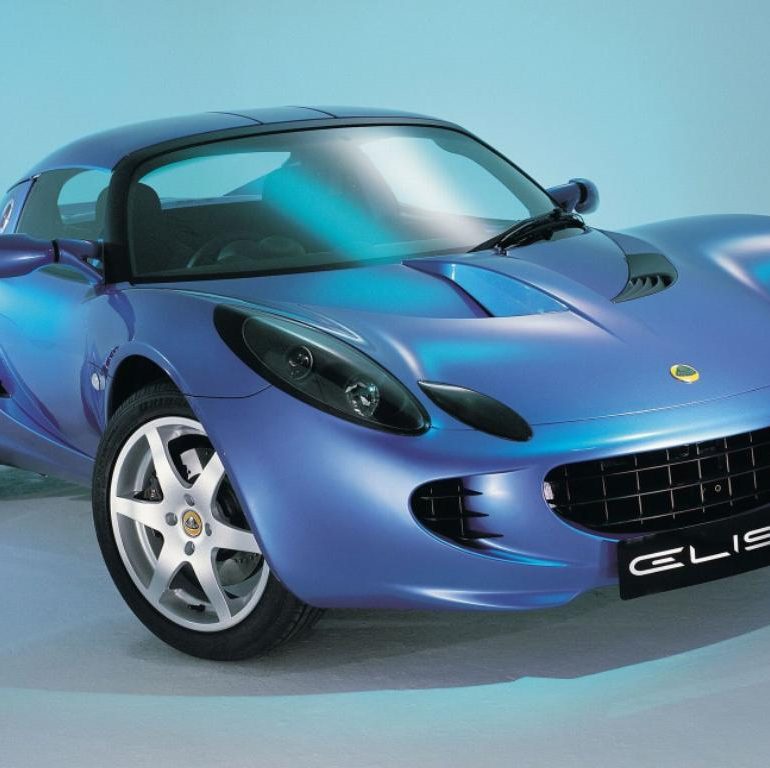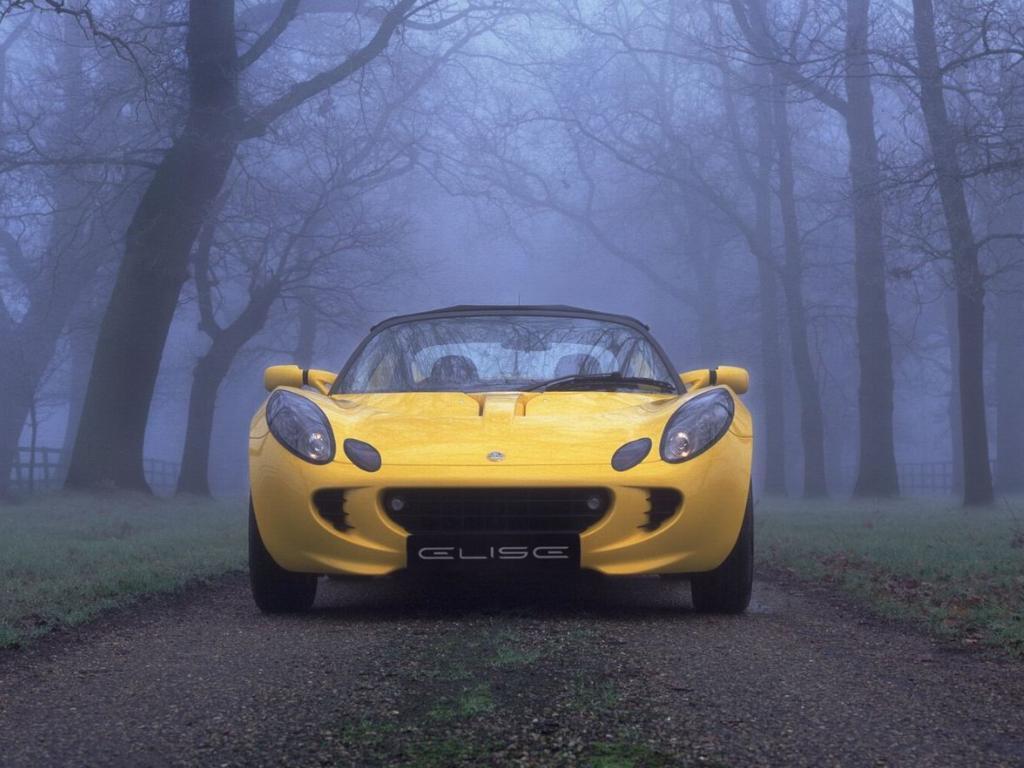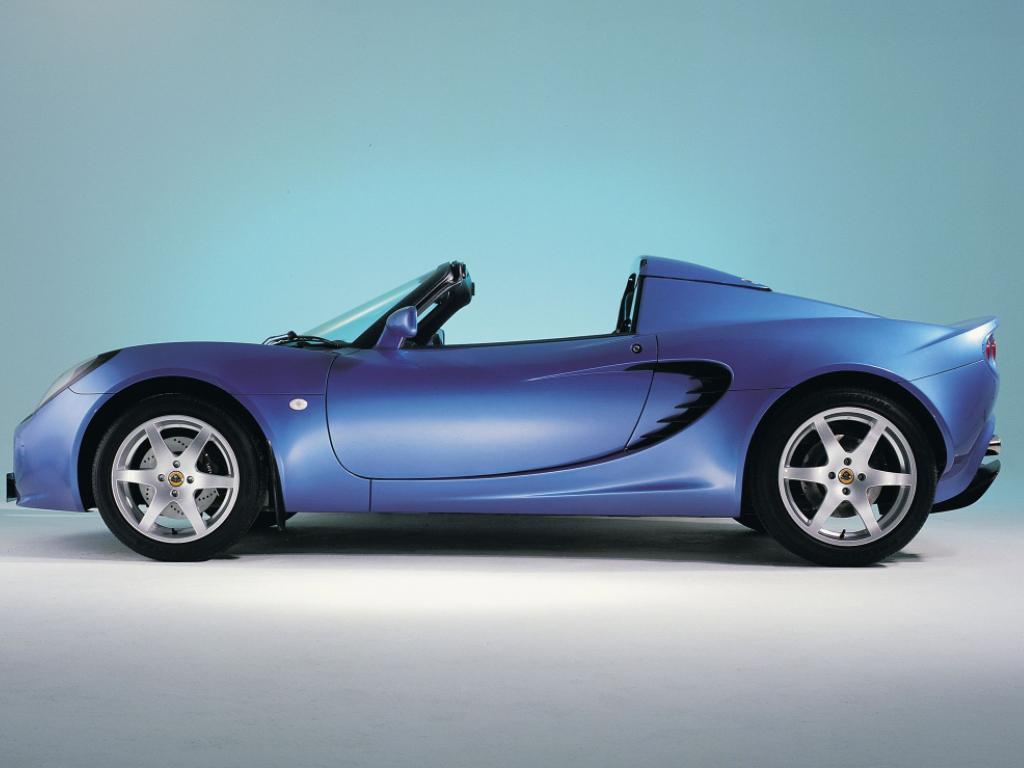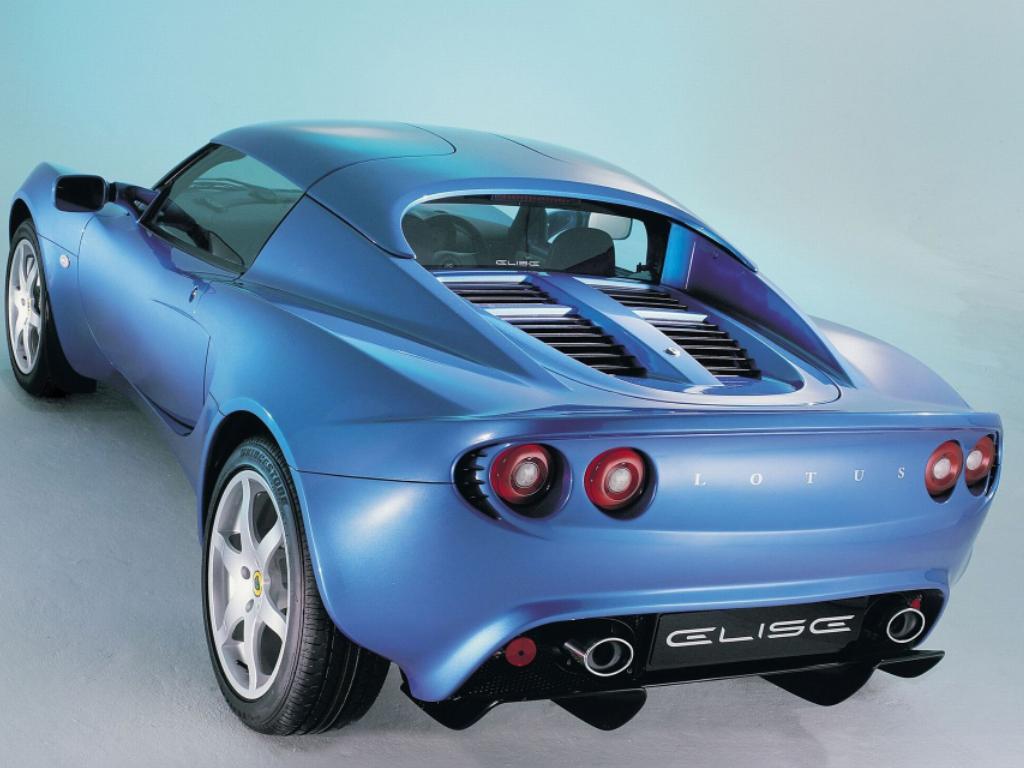2000 Lotus Elise 111S
In 2000 Lotus introduced the second generation Elise. This evolutionary car, arguably one of the most important cars in Lotus’ fifty-two year history, added to the technology introduced on the Elise in 1996.
The Elise was first unveiled at the Frankfurt Motorshow in 1995 before entering production with first deliveries in August 1996. That Elise introduced a range of technologies such as a chassis made from extruded and bonded aluminium, a composite energy absorbing front crash structure and lightweight composite body panels.
All Lotus Elises are hand assembled by skilled craftsmen at Lotus’ headquarters in Hethel, England. Each Elise takes about 100 man-hours to build and the final product is fine testament to the skills of Lotus.
Related: Lotus Race Car List / Lotus Current Lineup / All Lotus Models / Lotus News
When the open road calls, go out properly equipped
Having the right equipment adds to the pleasure of any task, and when the task in hand involves rising to the challenge of the open road, there’s only one tool for the job — the Elise 111S. More potent cousin to the standard Elise, the 111S adds extra power, a close short-ratio gearbox, and wider rear wheels and tyres to an already intoxicating formula. With its technically advanced 1.8-litre VVC engine producing 143bhp, the 111S packs a punch normally associated with cars of double the horsepower and three times the price. Recognisable by its rear-mounted aerofoil, six spoke road wheels, driving lamps, faired headlamp covers, ‘smoked’ front indicator lenses, different front grille, sports seats and carbon facia trim, the 111S ensures maximum enjoyment wherever you drive.
What the papers say…
“Behind the wheel of a Lotus Elise 111S, on a sunny morning on a deserted, twisty road, you will approach motoring nirvana. Lotus has cleverly matched the punchier engine with a close-ratio gearbox as standard. It gives you a choice of two gears for every corner, so if you get it slightly wrong the engine will have you back on the pace immediately. The 111S reaches 60mph in 5.38 seconds and 100mph in 14.4 — that’s moving closer to supercar territory. The cornering is sensational. In the purest sense, when you consider ultimate feel, no road car is better.’ The Times
Elise 111S – The natural evolution
The Lotus Elise 111S is a potent new derivative of the multi-award winning Elise. It is powered by a 143bhp (107kW) version of the renowned Rover K-Series VVC 1.8-litre engine, mated to a close-ratio gearbox, and provides a driving experience quite different to that of the standard Elise; it’s so different, in fact, that the Elise 111S is a separate model in the Lotus line-up.
With its top speed of 133 mph and its ability to catapult from standstill to 60mph in 5.38 seconds, and to 100mph in 14.4 seconds, the Elise 111S takes the Elise range even further into supercar territory, and at a fraction the price of Italian and German exotica.
In spite of its vast extra performance potential, the Elise 111S looks only subtly different from the standard car. It has a rear wing, a discreet ‘power bulge’ in the engine cover to accommodate the VVC engine’s valvegear, wider rear wheels and tyres to fully exploit the increased power, a new front grille, clear headlamp covers, ‘smoked’ front indicator lenses, carbon effect facia trim, and re-sculpted seats for greater comfort.
Special by Design
Although quite obviously of the Elise family, it was always the intention of Lotus engineers to make the Elise 111S a very different car to the standard model, and for it to appeal to a different type of buyer. Achieving a significant difference was a difficult task bearing in mind the extraordinary talents of the standard Elise.
David Minter, Executive Engineer – Lotus Cars, explains that, ”putting in the VVC engine on its own wasn’t enough to create the sort of gap between the Elise 111S and the standard car that we were after.
”It wasn’t until we had installed the set of close ratios in the gearbox, that we had the result we wanted. The Elise 111S has the feel and performance of a track car, and that’s how we expect many customers will use them. The Elise 111S develops upon all that is great about the standard car and adds a healthy dollop of aggressive performance”.
The New VVC Engine
At the heart of the new Elise 111S is the highly acclaimed Rover 1.8-litre K-Series VVC four-cylinder DOHC 16-valve engine, which produces 143 bhp (107kW) at 7000rpm. This uses the same aluminium alloy block as the 1796cc engine powering the standard Elise, but is topped by a sophisticated alloy cylinder head featuring Variable Valve Control — hence the VVC acronym.
Put in very simple terms, if an engine with fixed valve operation characteristics (non-variable) is tuned to give more top end power, low end torque suffers — a camshaft lobe profiled for strong performance at high engine speeds is very much the wrong shape for producing torque at lower revs.
The VVC system can be described as effectively creating a continuously variable (within specific, but widely based, limits) cam lobe ‘profile’, which alters the duration of the inlet valve opening and its phasing, according to both engine speed and loading, for optimum performance throughout the rev range. Controlled by an advanced engine management system, VVC allows the engine to achieve a healthy power output at high revs while maintaining respectable torque — a 174Nm (128lb ft) peak — at lower engine speeds.
As well as the VVC mechanism, this version of the 1.8-litre K-Series differs from the less powerful model in having larger inlet and exhaust valves, and a new inlet manifold and plenum chamber with increased flow capacities, all designed to further improve the engine’s breathing. The 1.8-litre VVC also features full sequential fuel injection with adaptive control, and distributorless ignition with individual coils for each cylinder.
One of the great advantages the VVC system has over other types of variable valve timing arrangements, is that it’s undetectable in operation. There’s no sudden step up in power, just a strong and seamless surge of energy, that continues all the way to the 7200rpm rev. limiter.
The VVC engine is 7kg (15lb) heavier than the standard 1.8-litre K-Series, and is slightly taller, necessitating a modest ‘power bulge’ in the composite engine cover.
A Close-ratio Gearbox — an Essential Partner to VVC
An essential addition to the VVC K-Series in the Elise 111S is a new set of internal ratios and a modified final drive for the five-speed manual gearbox. The new ratios are closely spaced in order to make the most of the VVC’s increased power — their spacing is such that if you use all of the available revs before changing gear, the engine will keep in its optimum power-band.
This ability to stay in the power-band during hard driving makes the Elise 111S ideal for track days, and further enhances the Elise’s supercar feel on the road.
Tyres — a Critical Ingredient
The increased power available from the new VVC K-series engine has resulted in wider rear tyres — they grow from the 205-width rubber on the standard Elise, to 225 for the Elise 111S. The front tyres are the same as those on the standard Elise.
As with the standard car, the tyres are Pirelli P-Zeros, but it wasn’t just a case of ordering them in a broader size. Lotus chassis engineers worked closely with Pirelli to develop a rear tyre specially for the Elise 111S, and although that tyre retains the P-Zero name, it has a modified construction and rubber compound compared to those of the 205-width tyres supplied for the standard Elise.
It took many months of testing, both at the track and on the open road, to get precisely the right tyre for the Elise 111S and then to fine-tune the suspension to achieve the optimum combination of grip, handling and ride quality.
According to David Minter, Executive Engineer – Lotus Cars, ”every second we spent testing was well worth the effort. The 225s give a considerable performance jump over the 205s, and we will now offer the wider tyre as an option for all Elises.”
A Chassis So Good It Hardly Needs Changing
Most uprated sports cars need a host of chassis modifications to cope with higher power outputs.
Not so the Elise 111S. The standard Elise chassis is so well developed and engineered, only the slightest changes were required to harness the extra horsepower.
In fact, the sum total of modifications amount to revised rear toe-steer angles to suit the broader tyres, wider rear wheels (up from 7.0J to 7.5J), again to accommodate the new tyres, and a 12mm increase in rear track to meet the demands of the fresh wheel and tyre combination.
Everything else — steering, dampers, springs, suspension bushing, — are unchanged from the standard Elise.
The Rest of the Changes, Inside and Out
For the Elise 111S, Lotus has kept styling changes to a minimum — no point spoiling a great-looking car. For enhanced high speed cornering stability there’s a rear wing to create extra downforce. Also at the back of the car are small, black-coloured spats at the trailing edge of the rear wheel arches, to cover the wider wheels and tyres. The 6 spoke alloy wheels are of a new design.
The engine cover now has a discreet ‘power bulge’ to accommodate the VVC K-series engine’s slightly taller cylinder head. Moving around to the front of the car, there’s a new ‘cookie-cutter’ grille, ‘smoked’ lenses for the indicators (which still flash orange), and perspex headlamp covers to create a smoother, more aerodynamic nose treatment.
The most important change inside the Elise is a revised seat design, which now has deeper foam cushions for enhanced comfort. While this might sound like a simple enough modification, it had to be achieved without raising the occupant’s hip height — the H-point, as it’s called in European safety legislation — above what it was previously (any increase in the H-point would have resulted in a fresh round of homologation tests). This design of seat will now be standard for all Elise models.
There are also new metal window winders, and carbon effect trimming on the facia.
Driving the Elise 111S
That the Elise 111S is a very different car to the standard Elise is clearly evident the first time you use full throttle. The VVC engine and the close-ratio gearbox combine to give aggressive power delivery and a startling rate of acceleration — standstill to 100 km/h takes just 5.4 seconds (0-60 mph in 5.38 seconds) and 0 to 160km/h (0-100mph) takes 14.4 seconds. And remember, that’s from a naturally aspirated 1.8-litre powerplant.
Compared with the standard Elise engine, the VVC is even more free-revving and has useful power all the way to the 7200rpm red-line. In fact, peak power (143bhp, 107kW) is developed at 7000rpm, in keeping with the Elise 111S’s role as a hard-charging sports car and weekend track star.
The closeness of the gearbox ratios and the swiftness of the gearchange mean that if you use the rev range to the full, the engine won’t fall out of its power-band and youŸll have urgent acceleration whenever you ask for it. The closeness of the ratios and the extra torque of the VVC powerplant also mean that even in the mid-range the Elise 111S gives a gutsy response to throttle commands.
The wider rear tyres do an excellent job of harnessing all this extra power and torque. Not only do they generate higher levels of road holding, but in doing so they allow the driver to take full advantage of the increased power and throttle response on the exit to corners.
Light Weight — Without It, None Of This Would Be Possible
Ever since the days of Colin Chapman, Lotus Cars’ famous founder, light weight has been the key to the success of Lotus sports cars. The mid-engined Elise represents the pinnacle of this ”light is right” philosophy.
The single greatest contributory factor to the lightness of the Elise is its remarkable chassis. Of a spaceframe tub design, it’s constructed of extruded anodised aluminium sections, bonded (glued) together rather than welded. Bonding not only allows far greater dimensional accuracy of the finished chassis, but also the Aluminium sections can be made thinner (therefore lighter) as the Aluminium is not subjected to the strength sapping welding process.
The Elise’s bare chassis tips the scales at a mere 68kg (150lb), yet has a torsional stiffness of 10133Nm per degree. That figure rises to 11000Nm per degree when the roll hoop and body are fitted to the chassis, a figure comparable to that of a unitary steel-bodied car and quite extraordinary for a roadster.
Once Lotus started to make the Elise light, then reducing weight became a self-perpetuating process. With less mass to propel, it’s possible fit a smaller, lighter engine and still achieve impressive performance figures. The Elise 111S has an engine of just 1.8 litres, yet can accelerate as quickly as sports cars costing three times as much.
Small engines come with small, light gearboxes. And a small engine is also an economical engine, which meant Lotus engineers could reduce the size, and therefore the weight, of the fuel tank while maintaining a respectable touring range.
Less weight to move along also means less weight which requires stopping. Which is why the Elise is able to do without a brake servo on the cross-drilled ventilated discs – thatŸs more weight saved. Similarly, such a light car does not require power assistance for it’s steering, shaving off still more kilograms
Handling considerations also strip more weight from the car. Having a low unsprung mass is the goal of all chassis engineers, the Elise benefits from extruded aluminium suspension uprights, monotube dampers (lighter than the twin-tube variety), and at the front, aluminium brake callipers.
A standard Elise weighs in at a mere 699kg (dry) and the Elise 111S at 714kg (dry). That the Elise is widely acknowledged as the best sports car in the world today, categorically proves the value of saving weight.
The dramatic arrival of the Elise 111S heralds a new era in supercars. It’s handily compact and exceptionally nimble, brutally powerful for its weight and electrifyingly fast. And if that weren’t enough, the Elise 111S is also one of the most enjoyable and satisfying sports cars in the world. People with a passion for driving are going to love every second in the Elise 111S.
Related: Lotus Race Car List / Lotus Current Lineup / All Lotus Models / Lotus News
Pictures
Specs & Performance
| submitted by | Richard Owen |
| engine | Rover K-series Inline-4 |
| position | Mid Transverse |
| aspiration | Natural |
| valvetrain | DOHC 4 Valves per Cyl |
| displacement | 1796 cc / 109.6 in³ |
| bore | 80 mm / 3.15 in |
| stroke | 89.3 mm / 3.52 in |
| power | 91.0 kw / 122.0 bhp @ 5500 rpm |
| specific output | 67.93 bhp per litre |
| bhp/weight | 171.83 bhp per tonne |
| torque | 168 nm / 123.9 ft lbs @ 4500 rpm |
| body / frame | Composite Body Panels Over Aluminum Spaceframe Structure |
| driven wheels | Mid Engine / RWD |
| front tires | 175/55VR16 |
| rear tires | 225/45VR17 |
| front brakes | Vented Discs |
| f brake size | x 282 mm / x 11.1 in |
| rear brakes | Vented Discs |
| r brake size | x 282 mm / x 11.1 in |
| front wheels | F 40.6 x 14.0 cm / 16.0 x 5.5 in |
| rear wheels | R 43.2 x 19.0 cm / 17.0 x 7.5 in |
| steering | Unassisted Rack & Pinion |
| f suspension | Double Wishbones w/Coil Springs over monotube Bilstein Dampers |
| r suspension | Double Wishbones w/Coil Springs over monotube Bilstein Dampers |
| curb weight | 710 kg / 1565 lbs |
| wheelbase | 2300 mm / 90.6 in |
| front track | 1457 mm / 57.4 in |
| rear track | 1503 mm / 59.2 in |
| length | 3785 mm / 149.0 in |
| width | 1719 mm / 67.7 in |
| height | 1143 mm / 45.0 in |
| transmission | 5-Speed Manual |
| gear ratios | 2.923:1, 1.750:1, 1.307:1, 1.033:1, 0.77:1, :1 |
| top speed | ~200 kph / 124.3 mph |
| 0 – 60 mph | ~5.6 seconds |
| 0 – 100 mph | ~17.1 seconds |












